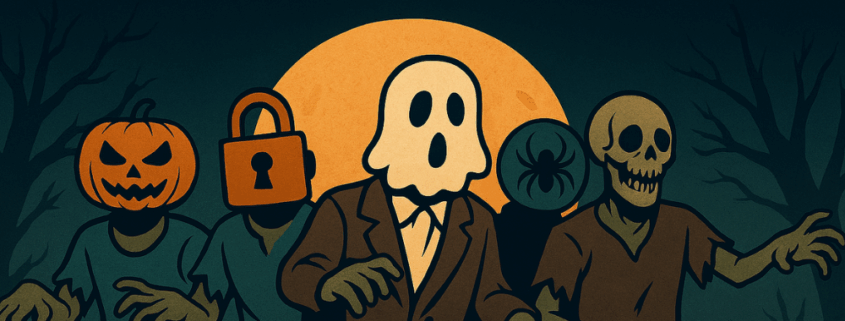Don’t Get Tricked: Spooky Cyber Threats to Watch Out For
As the nights grow longer and Halloween creeps closer, cyber threats are lurking in the shadows, ready to trick unsuspecting victims. While ghosts and goblins may be imaginary, the dangers of the digital world are very real. Here are some of the spookiest cyber threats to watch out for and how to avoid getting haunted by hackers.
🎃 1. Phishing: The Scary Disguise
Phishing emails are like costume parties for cybercriminals, they disguise themselves as trusted sources to lure you into clicking malicious links or sharing sensitive information. These messages often mimic banks, coworkers, or even popular brands.
How to stay safe:
- Always verify the sender’s email address.
- Hover over links before clicking.
- Never share personal info via email.
👻 2. Ransomware: The Hostage Horror
Ransomware is the equivalent of a haunted house. You’re trapped until you pay to escape. This malware locks your files and demands payment for their release, often in cryptocurrency.
How to stay safe:
- Keep software and antivirus tools updated.
- Back up your data regularly.
- Avoid downloading files from unknown sources.
🕷️ 3. Social Engineering: The Trickster’s Tactics
Cyber tricksters use psychological manipulation to gain access to systems or data. They might pretend to be IT support or a manager, convincing you to hand over credentials or perform risky actions.
How to stay safe:
- Be skeptical of urgent requests.
- Verify identities through official channels.
- Report suspicious behavior to your security team.
🦇 4. Malicious Apps: The Cursed Downloads
Some apps are more trick than treat. Malicious software can hide in seemingly harmless downloads, especially around holidays when themed apps are popular.
How to stay safe:
- Only download apps from official stores.
- Check reviews and permissions before installing.
- Use mobile security tools to scan for threats.
🧟 5. Zombie Accounts: The Undead Access Points
Old, unused accounts can become entry points for attackers. If they’re not properly secured or deactivated, they can be exploited without anyone noticing.
How to stay safe:
- Regularly audit and close unused accounts.
- Use strong, unique passwords.
- Enable multi-factor authentication wherever possible.
🪦 Bonus Threat: Shadow IT
Shadow IT refers to unauthorized software or systems used within an organization. While not always malicious, it can create vulnerabilities that attackers exploit.
How to defend yourself:
- Establish clear IT policies.
- Monitor network activity for unknown tools.
- Educate employees on approved software.
Cyber threats don’t take holidays off. This Halloween, don’t let your guard down. Whether you’re working from home, shopping online, or just browsing social media, stay informed and alert. The best defense against spooky cyber threats is awareness, preparation, and a healthy dose of skepticism.


